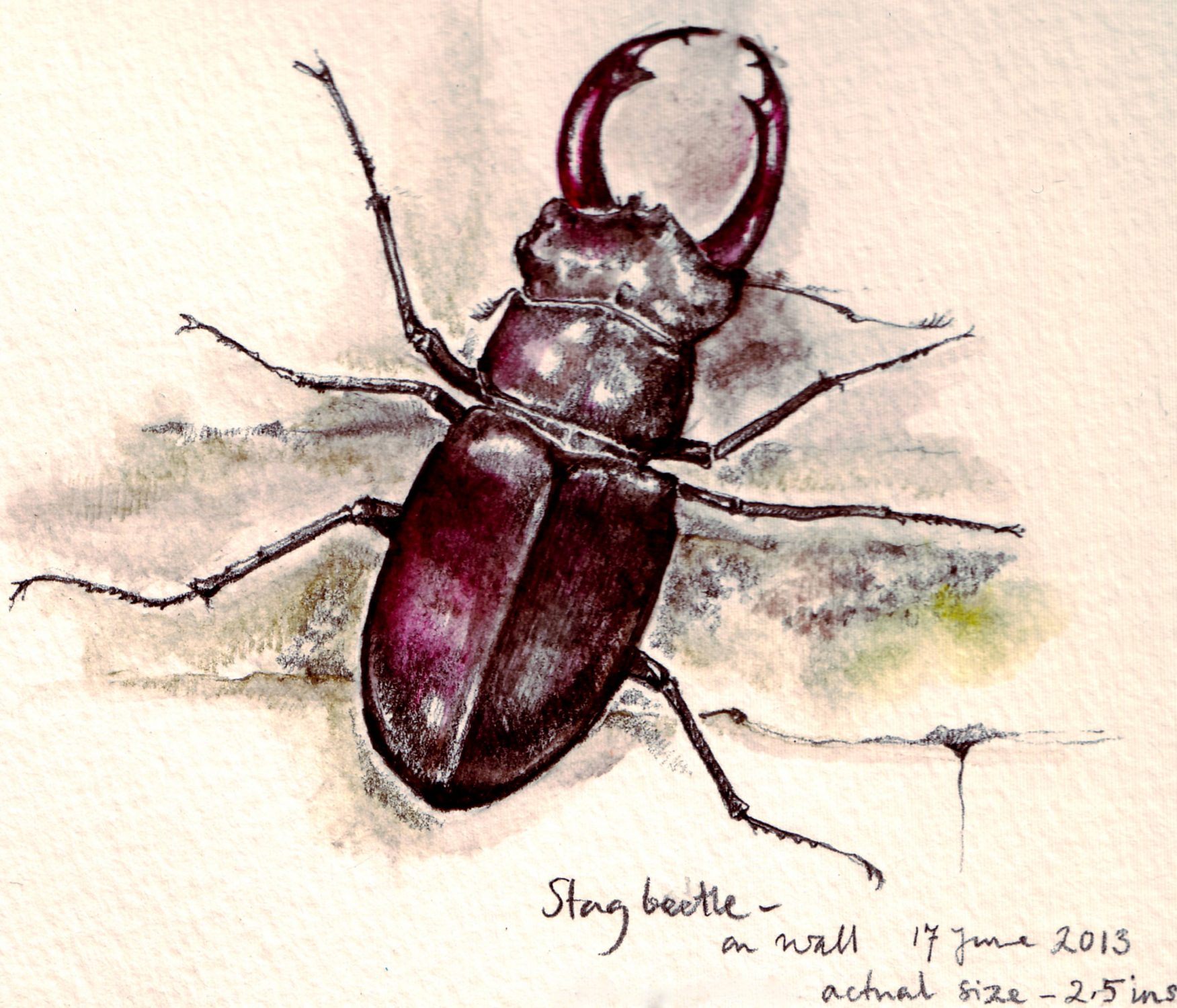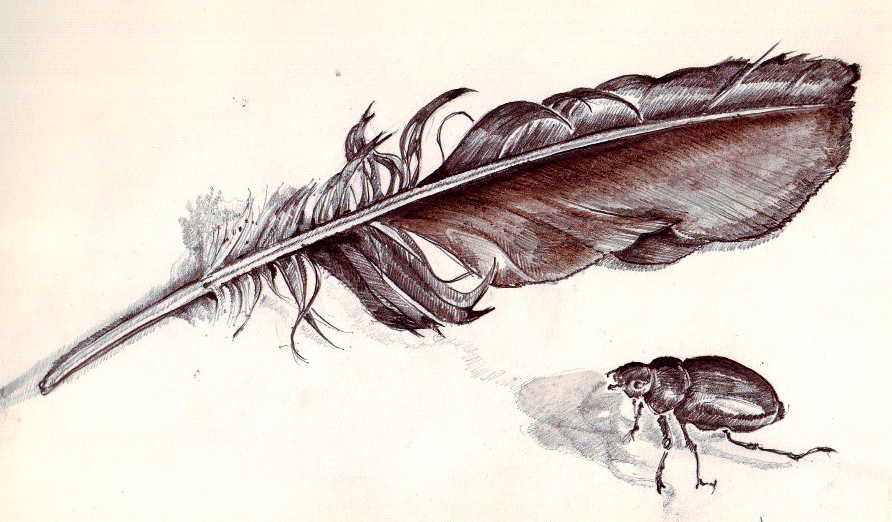
The strangest creatures are, to me,
The ones I love the best.
The creepy, crawly and the odd
Are cooler than the rest…
These magnificent beasties are the armoured vehicles of the insect population and the largest terrestrial-dwelling beetles in the UK. Their common name is a reference – unsurprisingly – to their antler-shaped “mandibles” or jaws, which they use to fight over territory, but not, perhaps surprisingly, to win the respect of female Stag Beetles..!
These Curious Creatures have intrigued me ever since I found an expired female stag beetle (see below ) in a south-west France many years ago. I drew it next to a blackbird’s feather, captivated by the different tones of black, the textural contrasts and inky depths of colour. I found it – and still find them all as a species – fascinating and beautiful, particularly the males, with their extraordinary maroon-red mandibles.

It’s the beetle with antlers as fine as a deer,
It’s the beetle whose mandibles fill you with fear;
Inky beast, black as night – it may give you a fright,
But its beauty is strikingly clear!
If you live in the south of England, look out for stag beetles between mid-May to late July. They seem to like south and west London in particular; probably because these areas that have lots of rotting/dead wood (the natural habitat and diet of the larvae). So leave those old logs at the end of the garden and let the stag beetles move in! They are an endangered species, probably due to the on going rate of development and “cleaning-up” of the countryside.
So leave those old logs at the end of the garden and let the stag beetles move in! They are an endangered species, probably due to the on going rate of development and “cleaning-up” of the countryside.
If you find one, you can record it on the Great Stag Hunt Survey here, on the pages of the People’s Trust for Endangered Species.
Fearsome and feisty, you zig and you zag;
A mechanical hum in a slow game of tag…
From a grub underground, you emerge and are found
In our gardens, magnificent stag!
Is it a bird, is it a plane? No, it’s a whirling, purring Stag Beetle that bobs towards you on a balmy summer’s evening like some kind of child’s remote-controlled mechanical toy! And (like the mystery of the bumble bee) you think, “How on earth does it actually manage to fly, with those massive mandibles, dangly legs and huge body?!” The noise they make is almost mechanical; a loud droning hum, and the sight is simultaneously alarming, magnificent and comical…
The noise they make is almost mechanical; a loud droning hum, and the sight is simultaneously alarming, magnificent and comical…
Stag beetle, strange beetle, ebony black,
With a chestnutty shell on your ravishing back!
In a blur you pass by, through the warm summer sky
Like a copter that’s under attack!
Four to six years of the Stag Beetle’s life is spent underground as a larva or grub; they can grow to a whopping 80mm during this period, feeding on their environment of rotting wood. When they finally emerge as adults, they live for only a few weeks and in this brief time, desperately search for mates, and areas that contain dead and decaying wood to lay their eggs in or in the surrounding soil. Because this habitat has become increasingly rare, their numbers have declined dramatically in the last 40 years, thus awarding them their endangered status.
I’ve had several curious encounters with these creatures but the following is perhaps the strangest.
 Several years ago now, it was early evening and I was gazing through the kitchen window onto our patio as I washed-up. In the fading light, my eyes came to rest on some small, freshly painted Warhammer* models of troll-like creatures my two young sons had left in the garden to dry.
Several years ago now, it was early evening and I was gazing through the kitchen window onto our patio as I washed-up. In the fading light, my eyes came to rest on some small, freshly painted Warhammer* models of troll-like creatures my two young sons had left in the garden to dry.
Do you know Warhammer? It is a fantasy game that includes small models to make and paint. Like this one.
As I watched, one of the larger models, a mighty-looking warrior-beasty thing, appeared to come to life and move silently forward in the dimness. I watched, disbelieving, thinking that perhaps Borrowers or elves existed after all. I finally went outside (rather fearfully) to investigate. The moving “Warhammer” beast was, you guessed it, a two and a half inch stag beetle!
So do not underestimate
The beetling, buzzing crew;
All creatures have a place on earth,
Including me and you!
CURIOUS CREATURE SUPER-POWER: The males have rocking-red antlers that may look scary but are purely to fight other males for territory.
HABITAT: parks and gardens, woodland and hedgerows; places with lots of rotting/dead wood.
LIFESPAN: 4-6 years as larvae – then just a few weeks as mature stag beetles.
DIET: larvae feed on decaying wood. The adult stags don’t seem to feed but do take moisture from rotting fruit or tree sap.
PREDATORS: the grubs are food for foxes and rats, but the large, slow-walking beetles are an easy target for birds, cats and sadly, some city-dwellers perish on pavements under the clumsy footfall of humans.
SIZE: the grubs can grow as big as 80mm and adult males up to 70mm, though the females can be as small as 25mm.
Look out for the next CURIOUS CREATURE in JUMP! MAG soon… and if you missed the previous CURIOUS CREATURE, the Midwife Toad, you can catch up here
Gabby Dawnay is a writer, poet and artist. She is a regular contributor to Okido magazine, a fab arts and science magazine for kids. In February 2014, Gabby’s first picture book called A Possum’s Tail – a collaboration with illustrator Alex Barrow – will be published, followed by a second book about London in July 2014. Both are by Tate Publishing. As well as writing children’s books and for children’s television, she does both private and commercial art commissions, which you can view on her blog.
© Gabby Dawnay 2013



